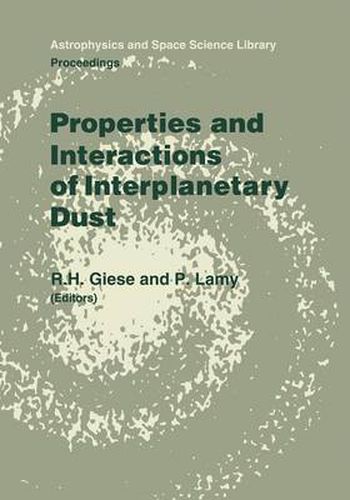Readings Newsletter
Become a Readings Member to make your shopping experience even easier.
Sign in or sign up for free!
You’re not far away from qualifying for FREE standard shipping within Australia
You’ve qualified for FREE standard shipping within Australia
The cart is loading…






This title is printed to order. This book may have been self-published. If so, we cannot guarantee the quality of the content. In the main most books will have gone through the editing process however some may not. We therefore suggest that you be aware of this before ordering this book. If in doubt check either the author or publisher’s details as we are unable to accept any returns unless they are faulty. Please contact us if you have any questions.
Investigation of the interplanetary dust cloud is characterized by contributions from quite different methods and fields, such as research on zodiacal light, meteors, micrometeoroids, asteroids, and comets. Since the earth’s environment and interplanetary space became accessible to space vehicles these interrelations are clearly evident and extremely useful. Space measurements by micrometeoroid detectors, for example, provide individual and eventually detailed information on impact events, which however are limited in number and therefore restricted in statistical significance. On the other hand, zodiacal light measurements involve scattered light from many particles and therefore provide global information about the average values of physical properties and spatial distribution of interplanetary grains. Additional knowledge stems from lunar samples and from dust collections in the atmosphere and in deep sea sediments. All these sources of complementary information must be put together into a synoptical synthesis. This also has to take into account dynamical aspects and the results of laboratory investigations concerning physical properties of small grains. Such considerable effort is not merely an academic exercise for a few specialists interested in the solar dust cloud. Since this same cloud exclusively allows direct in-situ acess to investigate extraterrestrial dust particles over a wide range of sizes and materials, it provides valuable information for realistic treatment of dust phenomena in other remote cosmic regions such as in dense molecular clouds, circumstellar dust shells, and even protostellar or protoplanetary systems.
$9.00 standard shipping within Australia
FREE standard shipping within Australia for orders over $100.00
Express & International shipping calculated at checkout
This title is printed to order. This book may have been self-published. If so, we cannot guarantee the quality of the content. In the main most books will have gone through the editing process however some may not. We therefore suggest that you be aware of this before ordering this book. If in doubt check either the author or publisher’s details as we are unable to accept any returns unless they are faulty. Please contact us if you have any questions.
Investigation of the interplanetary dust cloud is characterized by contributions from quite different methods and fields, such as research on zodiacal light, meteors, micrometeoroids, asteroids, and comets. Since the earth’s environment and interplanetary space became accessible to space vehicles these interrelations are clearly evident and extremely useful. Space measurements by micrometeoroid detectors, for example, provide individual and eventually detailed information on impact events, which however are limited in number and therefore restricted in statistical significance. On the other hand, zodiacal light measurements involve scattered light from many particles and therefore provide global information about the average values of physical properties and spatial distribution of interplanetary grains. Additional knowledge stems from lunar samples and from dust collections in the atmosphere and in deep sea sediments. All these sources of complementary information must be put together into a synoptical synthesis. This also has to take into account dynamical aspects and the results of laboratory investigations concerning physical properties of small grains. Such considerable effort is not merely an academic exercise for a few specialists interested in the solar dust cloud. Since this same cloud exclusively allows direct in-situ acess to investigate extraterrestrial dust particles over a wide range of sizes and materials, it provides valuable information for realistic treatment of dust phenomena in other remote cosmic regions such as in dense molecular clouds, circumstellar dust shells, and even protostellar or protoplanetary systems.